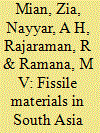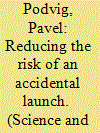|
|
|
Sort Order |
|
|
|
Items / Page
|
|
|
|
|
|
|
| Srl | Item |
| 1 |
ID:
075375


|
|
|
|
|
| Publication |
2006.
|
| Summary/Abstract |
We describe the industrial project that a "proliferator" would conduct to produce a first, small batch of nuclear weapons. From refining yellowcake ore to final weapons assembly, we highlight the project's tasks and their interactions. The proliferator can choose alternative production technologies that offer quicker completion, but at higher cost in terms of limited resources. The proliferator can also expedite his project by devoting more resources to critical tasks. From physics and chemistry, we determine raw material requirements. From industrial engineering and materials science, we convert these requirements into estimates of the time, manpower, energy, and money required to complete each task under normal and expedited conditions. Using generalized project-management analysis tools, we then estimate the earliest possible completion time of the project, assuming two different levels of resource availability. We also estimate the time required to complete a weapon if some of the project's steps can be skipped; for example, if the proliferator acquires stolen, highly enriched uranium metal.
|
|
|
|
|
|
|
|
|
|
|
|
|
|
|
|
| 2 |
ID:
075374


|
|
|
|
|
| Publication |
2006.
|
| Summary/Abstract |
We investigate the problem of detecting the presence of clandestine neutron sources, such as would be produced by nuclear weapons containing plutonium, within cargo containers. Small, simple, and economical semiconductor photodiode detectors affixed to the outsides of containers are capable of producing statistically robust detections of unshielded sources when their output is integrated over the durations of ocean voyages. It is possible to shield such sources with thick layers of neutron-absorbing material, and to minimize the effects of such absorbers on ambient or artificial external neutron fluxes by surrounding them with neutron-reflective material.
|
|
|
|
|
|
|
|
|
|
|
|
|
|
|
|
| 3 |
ID:
075373


|
|
|
|
|
| Publication |
2006.
|
| Summary/Abstract |
The July 2005 U.S.-India joint statement represents a fundamental transformation of U.S.-India relations and at the same time a challenge to the disarmament and non-proliferation regimes. There is concern that the March 2006 separation plan proposed by India for demarcating its military and civilian nuclear facilities may allow a potentially rapid expansion of its capacity for fissile material production for weapons. In this analysis, we have assessed fissile material production capabilities in India and how they might change as a result of the U.S.-India deal. We look at current stockpiles of fissile materials in India and Pakistan and estimate the changing capacity for future fissile material production as India progressively places some of its heavy water reactors under safeguards. We assess India's uranium resource constraints and the additional weapons grade plutonium production in its unsafeguarded heavy water power reactors that would be made possible by imports of uranium allowed by the deal. We also estimate the weapons plutonium production from India's fast breeder reactor that is under construction and is to be unsafeguarded.
|
|
|
|
|
|
|
|
|
|
|
|
|
|
|
|
| 4 |
ID:
075376


|
|
|
|
|
| Publication |
2006.
|
| Summary/Abstract |
The potential role of nuclear fission to meet increased future energy demand while reducing greenhouse gas emissions and controlling nuclear proliferation is assessed. The World Energy Council projection for an environmentally driven future is used, which projects deployment of nearly 3 TW(e) of nuclear generation by 2100, with concurrent reduction of global CO2 emissions to one-third of present levels. We simulate three scenarios based on this demand curve that rely on evolutionary and advanced systems of reactors. The scenarios differ only in fuel cycle choice between once-through, transmutation, and breeding. We show that the cost of nuclear power will likely remain a minimum using the once through fuel cycle, which, we argue, also minimizes proliferation risks. The other two fuel cycle choices have the benefits of decreased waste production and increased uranium resource utilization, but these come at a price that is probably not acceptable unless the cost of repository space increases dramatically, or the cost of building advanced transmuting or breeding reactors can be reduced to a level lower than that of constructing new plants with contemporary technology. The importance of choice of discount rate in allocating resources to advanced nuclear technologies is discussed. The linkage of fuel cycle choice with the international non-proliferation regime is emphasized.
|
|
|
|
|
|
|
|
|
|
|
|
|
|
|
|
| 5 |
ID:
075372


|
|
|
|
|
| Publication |
2006.
|
| Summary/Abstract |
One of the serious risks associated with the strategic nuclear arsenals of Russia and the United States is that an accidental launch might result from a false alarm or from misinterpreting information provided by an early-warning system. This risk will not be reduced by bringing down the number of strategic missiles on high alert to the level of about 500 warheads on each side because this measure will not significantly affect first-strike vulnerability of the Russian strategic forces. Other measures that have been suggested so far, namely an upgrade of the Russian early-warning system, establishing additional channels of real-time exchange of early-warning data, or transparent and verifiable de-alerting of strategic forces, are more likely to increase the probability of an accident than to reduce it. To address the problem of an accidental launch in the short term, the United States and Russia, while continuing to work toward deep reductions of their strategic nuclear forces, should develop and implement measures that would keep their entire forces at low levels of readiness without revealing their actual alert status.
|
|
|
|
|
|
|
|
|
|
|
|
|
|
|
|
|
|
|
|
|